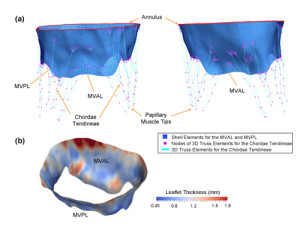
Different views of the reconstructed finite element (FE) model for the ovine mitral valve apparatus with anatomically accurate leaflets represented by shell elements.
Over at TACC, Jorge Salazar writes that new supercomputer simulations are helping doctors improve the repair and replacement of heart valves.
New supercomputer models have come closer than ever to capturing the behavior of normal human heart valves and their replacements, according to recent studies by groups including scientists at the Institute for Computational Engineering and Sciences (ICES) at The University of Texas at Austin and the Department of Mechanical Engineering at Iowa State University.
ICES has a long history with TACC. Since 2003, ICES has used supercomputers at the Texas Advanced Computing Center (TACC) to study turbulent flow. These recent studies that model the leaflet tissue-blood flow interactions through replacement human heart valves have used millions of CPU hours on the Stampede, Lonestar, and Maverick supercomputers at TACC.
The studies focused on how heart valve tissue responds to realistic blood flow. The new models can help doctors make more durable repair and replacement of heart valves.
At the core of what we do is the development of new material models that are much more structurally and biologically informed and can actually integrate mechanisms of failure and remodeling, growth, and adaptation to altered forces that go on,” said study co-author Michael Sacks.
Sacks sees this research impacting just about anybody who’s going to get the next generation of heart valve replacements, especially the percutaneous, or non-surgically replaced artificial valve.
Essentially, what you want to do is be able to engineer these devices the same way one engineers your iPhone,” Sacks said. “At the end of the day the goal is to be able to produce a more effective therapy. That’s it. We’re using these modeling techniques to be able to do that.”




